An Analysis of Supply Side Policies for UK Economic Growth
VerifiedAdded on 2020/06/05
|10
|3165
|55
Report
AI Summary
This report delves into the application of supply-side policies to facilitate economic growth, primarily focusing on the UK. It begins by defining supply-side policies and their aim to maximize aggregate supply by improving factors of production. The report discusses the benefits, such as lower inflation and increased employment, and categorizes these policies into interventionist and free market approaches, providing examples like deregulation and investment in public sectors. It also analyzes various supply-side policies that the UK government could adopt, including labor market reforms, capital market enhancements, entrepreneurship encouragement, and improvements in competition and efficiency. The report also addresses the limitations of these policies, such as the time required for implementation and potential political unpopularity. The document concludes by assessing the overall impact of supply-side policies on UK economic growth.
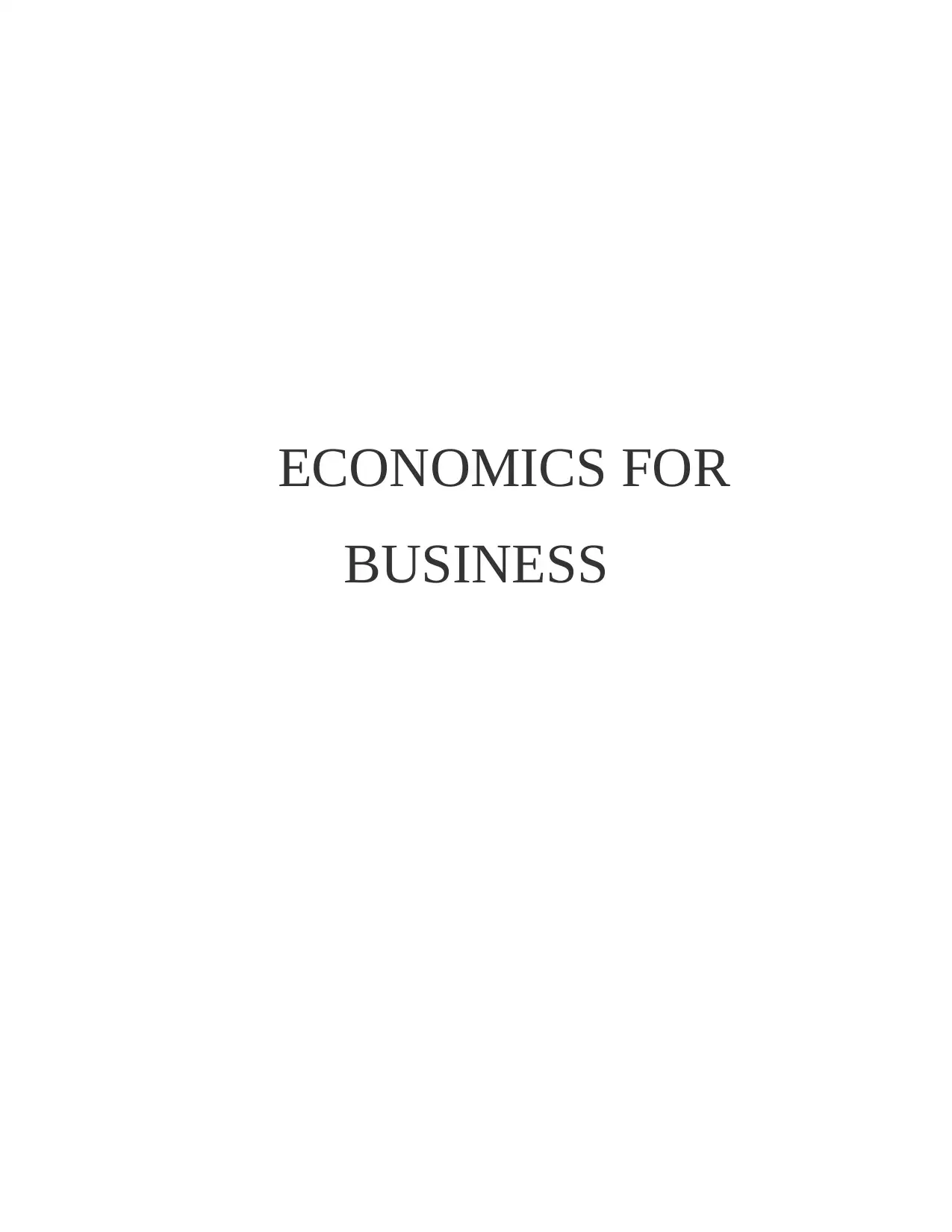
ECONOMICS FOR
BUSINESS
BUSINESS
Paraphrase This Document
Need a fresh take? Get an instant paraphrase of this document with our AI Paraphraser
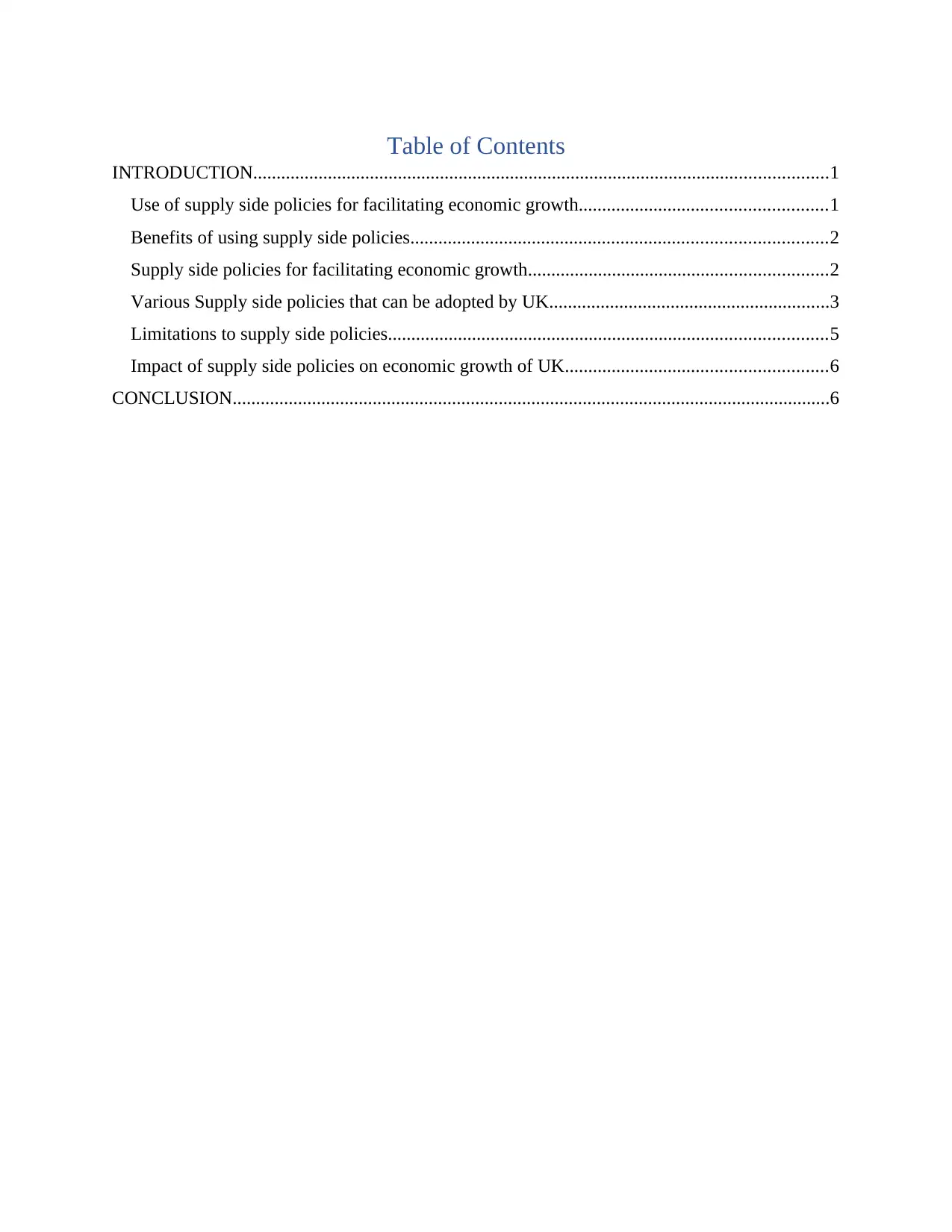
Table of Contents
INTRODUCTION...........................................................................................................................1
Use of supply side policies for facilitating economic growth.....................................................1
Benefits of using supply side policies.........................................................................................2
Supply side policies for facilitating economic growth................................................................2
Various Supply side policies that can be adopted by UK............................................................3
Limitations to supply side policies..............................................................................................5
Impact of supply side policies on economic growth of UK........................................................6
CONCLUSION................................................................................................................................6
INTRODUCTION...........................................................................................................................1
Use of supply side policies for facilitating economic growth.....................................................1
Benefits of using supply side policies.........................................................................................2
Supply side policies for facilitating economic growth................................................................2
Various Supply side policies that can be adopted by UK............................................................3
Limitations to supply side policies..............................................................................................5
Impact of supply side policies on economic growth of UK........................................................6
CONCLUSION................................................................................................................................6
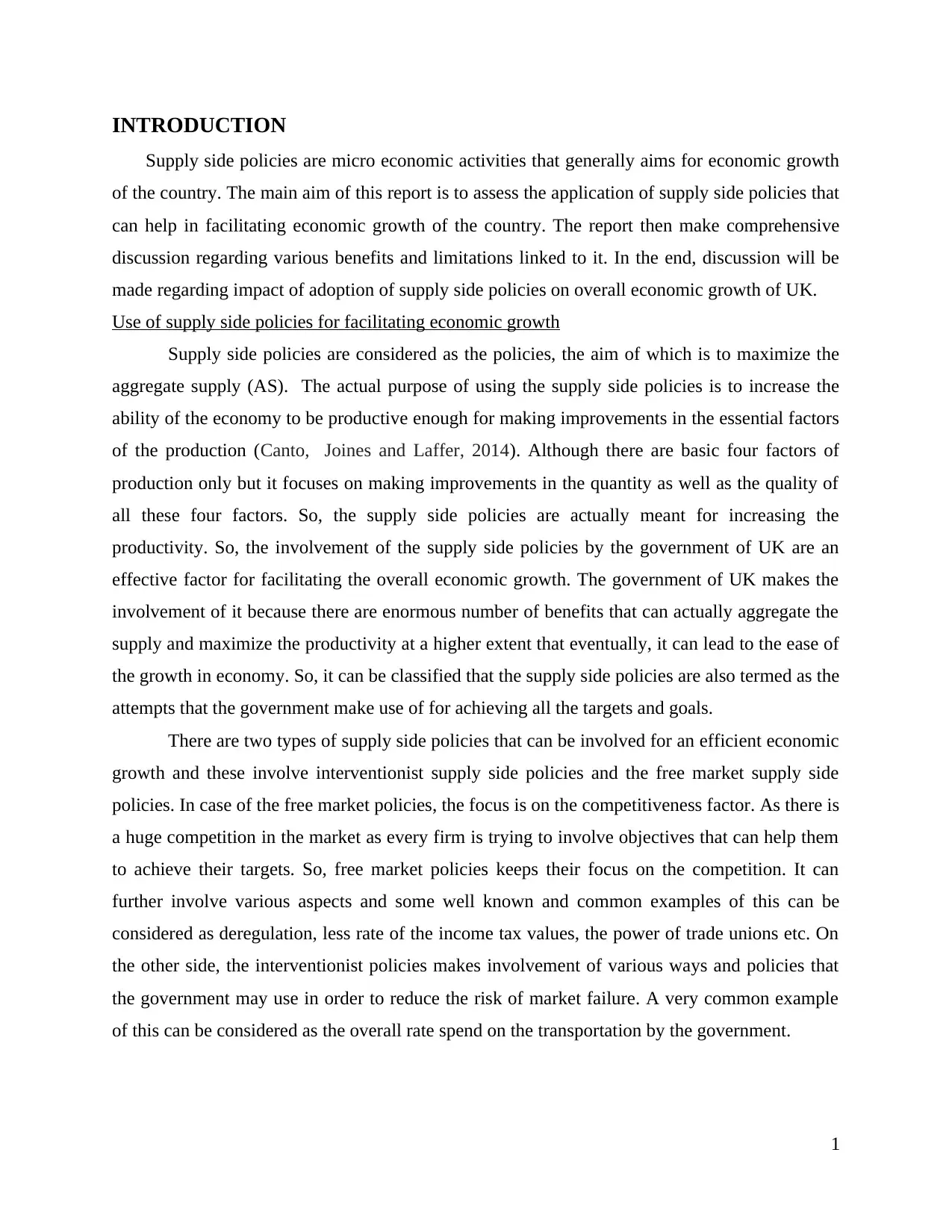
INTRODUCTION
Supply side policies are micro economic activities that generally aims for economic growth
of the country. The main aim of this report is to assess the application of supply side policies that
can help in facilitating economic growth of the country. The report then make comprehensive
discussion regarding various benefits and limitations linked to it. In the end, discussion will be
made regarding impact of adoption of supply side policies on overall economic growth of UK.
Use of supply side policies for facilitating economic growth
Supply side policies are considered as the policies, the aim of which is to maximize the
aggregate supply (AS). The actual purpose of using the supply side policies is to increase the
ability of the economy to be productive enough for making improvements in the essential factors
of the production (Canto, Joines and Laffer, 2014). Although there are basic four factors of
production only but it focuses on making improvements in the quantity as well as the quality of
all these four factors. So, the supply side policies are actually meant for increasing the
productivity. So, the involvement of the supply side policies by the government of UK are an
effective factor for facilitating the overall economic growth. The government of UK makes the
involvement of it because there are enormous number of benefits that can actually aggregate the
supply and maximize the productivity at a higher extent that eventually, it can lead to the ease of
the growth in economy. So, it can be classified that the supply side policies are also termed as the
attempts that the government make use of for achieving all the targets and goals.
There are two types of supply side policies that can be involved for an efficient economic
growth and these involve interventionist supply side policies and the free market supply side
policies. In case of the free market policies, the focus is on the competitiveness factor. As there is
a huge competition in the market as every firm is trying to involve objectives that can help them
to achieve their targets. So, free market policies keeps their focus on the competition. It can
further involve various aspects and some well known and common examples of this can be
considered as deregulation, less rate of the income tax values, the power of trade unions etc. On
the other side, the interventionist policies makes involvement of various ways and policies that
the government may use in order to reduce the risk of market failure. A very common example
of this can be considered as the overall rate spend on the transportation by the government.
1
Supply side policies are micro economic activities that generally aims for economic growth
of the country. The main aim of this report is to assess the application of supply side policies that
can help in facilitating economic growth of the country. The report then make comprehensive
discussion regarding various benefits and limitations linked to it. In the end, discussion will be
made regarding impact of adoption of supply side policies on overall economic growth of UK.
Use of supply side policies for facilitating economic growth
Supply side policies are considered as the policies, the aim of which is to maximize the
aggregate supply (AS). The actual purpose of using the supply side policies is to increase the
ability of the economy to be productive enough for making improvements in the essential factors
of the production (Canto, Joines and Laffer, 2014). Although there are basic four factors of
production only but it focuses on making improvements in the quantity as well as the quality of
all these four factors. So, the supply side policies are actually meant for increasing the
productivity. So, the involvement of the supply side policies by the government of UK are an
effective factor for facilitating the overall economic growth. The government of UK makes the
involvement of it because there are enormous number of benefits that can actually aggregate the
supply and maximize the productivity at a higher extent that eventually, it can lead to the ease of
the growth in economy. So, it can be classified that the supply side policies are also termed as the
attempts that the government make use of for achieving all the targets and goals.
There are two types of supply side policies that can be involved for an efficient economic
growth and these involve interventionist supply side policies and the free market supply side
policies. In case of the free market policies, the focus is on the competitiveness factor. As there is
a huge competition in the market as every firm is trying to involve objectives that can help them
to achieve their targets. So, free market policies keeps their focus on the competition. It can
further involve various aspects and some well known and common examples of this can be
considered as deregulation, less rate of the income tax values, the power of trade unions etc. On
the other side, the interventionist policies makes involvement of various ways and policies that
the government may use in order to reduce the risk of market failure. A very common example
of this can be considered as the overall rate spend on the transportation by the government.
1
⊘ This is a preview!⊘
Do you want full access?
Subscribe today to unlock all pages.

Trusted by 1+ million students worldwide
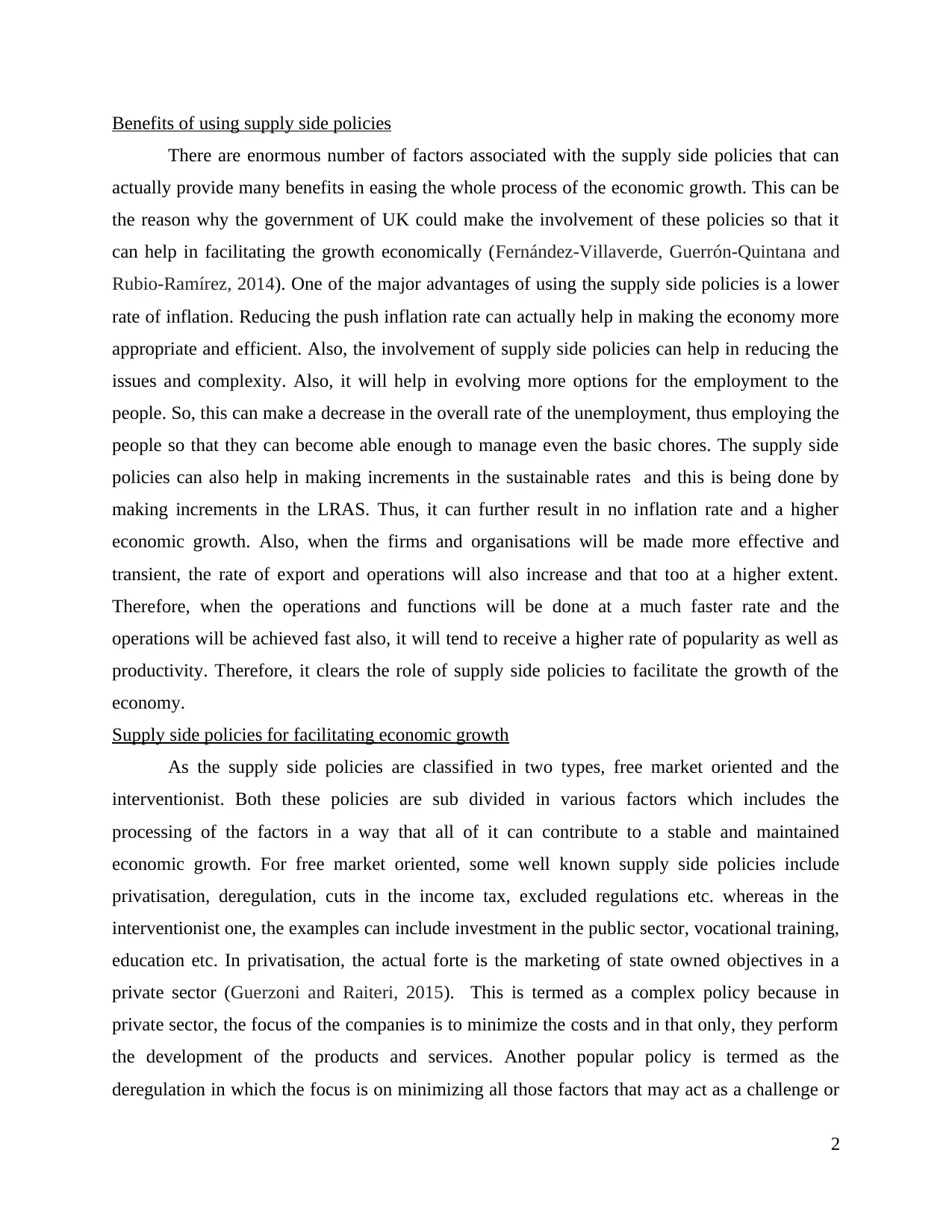
Benefits of using supply side policies
There are enormous number of factors associated with the supply side policies that can
actually provide many benefits in easing the whole process of the economic growth. This can be
the reason why the government of UK could make the involvement of these policies so that it
can help in facilitating the growth economically (Fernández-Villaverde, Guerrón-Quintana and
Rubio-Ramírez, 2014). One of the major advantages of using the supply side policies is a lower
rate of inflation. Reducing the push inflation rate can actually help in making the economy more
appropriate and efficient. Also, the involvement of supply side policies can help in reducing the
issues and complexity. Also, it will help in evolving more options for the employment to the
people. So, this can make a decrease in the overall rate of the unemployment, thus employing the
people so that they can become able enough to manage even the basic chores. The supply side
policies can also help in making increments in the sustainable rates and this is being done by
making increments in the LRAS. Thus, it can further result in no inflation rate and a higher
economic growth. Also, when the firms and organisations will be made more effective and
transient, the rate of export and operations will also increase and that too at a higher extent.
Therefore, when the operations and functions will be done at a much faster rate and the
operations will be achieved fast also, it will tend to receive a higher rate of popularity as well as
productivity. Therefore, it clears the role of supply side policies to facilitate the growth of the
economy.
Supply side policies for facilitating economic growth
As the supply side policies are classified in two types, free market oriented and the
interventionist. Both these policies are sub divided in various factors which includes the
processing of the factors in a way that all of it can contribute to a stable and maintained
economic growth. For free market oriented, some well known supply side policies include
privatisation, deregulation, cuts in the income tax, excluded regulations etc. whereas in the
interventionist one, the examples can include investment in the public sector, vocational training,
education etc. In privatisation, the actual forte is the marketing of state owned objectives in a
private sector (Guerzoni and Raiteri, 2015). This is termed as a complex policy because in
private sector, the focus of the companies is to minimize the costs and in that only, they perform
the development of the products and services. Another popular policy is termed as the
deregulation in which the focus is on minimizing all those factors that may act as a challenge or
2
There are enormous number of factors associated with the supply side policies that can
actually provide many benefits in easing the whole process of the economic growth. This can be
the reason why the government of UK could make the involvement of these policies so that it
can help in facilitating the growth economically (Fernández-Villaverde, Guerrón-Quintana and
Rubio-Ramírez, 2014). One of the major advantages of using the supply side policies is a lower
rate of inflation. Reducing the push inflation rate can actually help in making the economy more
appropriate and efficient. Also, the involvement of supply side policies can help in reducing the
issues and complexity. Also, it will help in evolving more options for the employment to the
people. So, this can make a decrease in the overall rate of the unemployment, thus employing the
people so that they can become able enough to manage even the basic chores. The supply side
policies can also help in making increments in the sustainable rates and this is being done by
making increments in the LRAS. Thus, it can further result in no inflation rate and a higher
economic growth. Also, when the firms and organisations will be made more effective and
transient, the rate of export and operations will also increase and that too at a higher extent.
Therefore, when the operations and functions will be done at a much faster rate and the
operations will be achieved fast also, it will tend to receive a higher rate of popularity as well as
productivity. Therefore, it clears the role of supply side policies to facilitate the growth of the
economy.
Supply side policies for facilitating economic growth
As the supply side policies are classified in two types, free market oriented and the
interventionist. Both these policies are sub divided in various factors which includes the
processing of the factors in a way that all of it can contribute to a stable and maintained
economic growth. For free market oriented, some well known supply side policies include
privatisation, deregulation, cuts in the income tax, excluded regulations etc. whereas in the
interventionist one, the examples can include investment in the public sector, vocational training,
education etc. In privatisation, the actual forte is the marketing of state owned objectives in a
private sector (Guerzoni and Raiteri, 2015). This is termed as a complex policy because in
private sector, the focus of the companies is to minimize the costs and in that only, they perform
the development of the products and services. Another popular policy is termed as the
deregulation in which the focus is on minimizing all those factors that may act as a challenge or
2
Paraphrase This Document
Need a fresh take? Get an instant paraphrase of this document with our AI Paraphraser
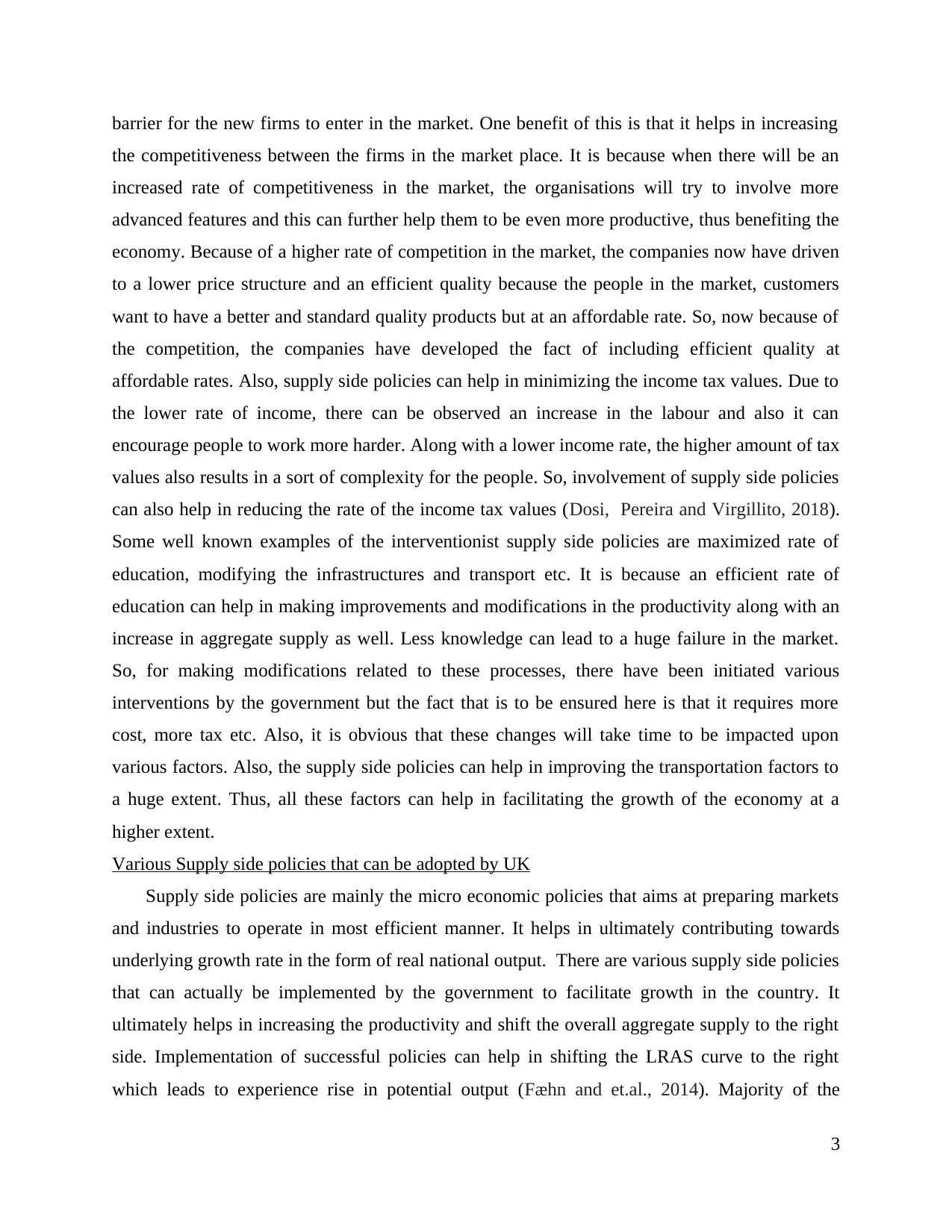
barrier for the new firms to enter in the market. One benefit of this is that it helps in increasing
the competitiveness between the firms in the market place. It is because when there will be an
increased rate of competitiveness in the market, the organisations will try to involve more
advanced features and this can further help them to be even more productive, thus benefiting the
economy. Because of a higher rate of competition in the market, the companies now have driven
to a lower price structure and an efficient quality because the people in the market, customers
want to have a better and standard quality products but at an affordable rate. So, now because of
the competition, the companies have developed the fact of including efficient quality at
affordable rates. Also, supply side policies can help in minimizing the income tax values. Due to
the lower rate of income, there can be observed an increase in the labour and also it can
encourage people to work more harder. Along with a lower income rate, the higher amount of tax
values also results in a sort of complexity for the people. So, involvement of supply side policies
can also help in reducing the rate of the income tax values (Dosi, Pereira and Virgillito, 2018).
Some well known examples of the interventionist supply side policies are maximized rate of
education, modifying the infrastructures and transport etc. It is because an efficient rate of
education can help in making improvements and modifications in the productivity along with an
increase in aggregate supply as well. Less knowledge can lead to a huge failure in the market.
So, for making modifications related to these processes, there have been initiated various
interventions by the government but the fact that is to be ensured here is that it requires more
cost, more tax etc. Also, it is obvious that these changes will take time to be impacted upon
various factors. Also, the supply side policies can help in improving the transportation factors to
a huge extent. Thus, all these factors can help in facilitating the growth of the economy at a
higher extent.
Various Supply side policies that can be adopted by UK
Supply side policies are mainly the micro economic policies that aims at preparing markets
and industries to operate in most efficient manner. It helps in ultimately contributing towards
underlying growth rate in the form of real national output. There are various supply side policies
that can actually be implemented by the government to facilitate growth in the country. It
ultimately helps in increasing the productivity and shift the overall aggregate supply to the right
side. Implementation of successful policies can help in shifting the LRAS curve to the right
which leads to experience rise in potential output (Fæhn and et.al., 2014). Majority of the
3
the competitiveness between the firms in the market place. It is because when there will be an
increased rate of competitiveness in the market, the organisations will try to involve more
advanced features and this can further help them to be even more productive, thus benefiting the
economy. Because of a higher rate of competition in the market, the companies now have driven
to a lower price structure and an efficient quality because the people in the market, customers
want to have a better and standard quality products but at an affordable rate. So, now because of
the competition, the companies have developed the fact of including efficient quality at
affordable rates. Also, supply side policies can help in minimizing the income tax values. Due to
the lower rate of income, there can be observed an increase in the labour and also it can
encourage people to work more harder. Along with a lower income rate, the higher amount of tax
values also results in a sort of complexity for the people. So, involvement of supply side policies
can also help in reducing the rate of the income tax values (Dosi, Pereira and Virgillito, 2018).
Some well known examples of the interventionist supply side policies are maximized rate of
education, modifying the infrastructures and transport etc. It is because an efficient rate of
education can help in making improvements and modifications in the productivity along with an
increase in aggregate supply as well. Less knowledge can lead to a huge failure in the market.
So, for making modifications related to these processes, there have been initiated various
interventions by the government but the fact that is to be ensured here is that it requires more
cost, more tax etc. Also, it is obvious that these changes will take time to be impacted upon
various factors. Also, the supply side policies can help in improving the transportation factors to
a huge extent. Thus, all these factors can help in facilitating the growth of the economy at a
higher extent.
Various Supply side policies that can be adopted by UK
Supply side policies are mainly the micro economic policies that aims at preparing markets
and industries to operate in most efficient manner. It helps in ultimately contributing towards
underlying growth rate in the form of real national output. There are various supply side policies
that can actually be implemented by the government to facilitate growth in the country. It
ultimately helps in increasing the productivity and shift the overall aggregate supply to the right
side. Implementation of successful policies can help in shifting the LRAS curve to the right
which leads to experience rise in potential output (Fæhn and et.al., 2014). Majority of the
3
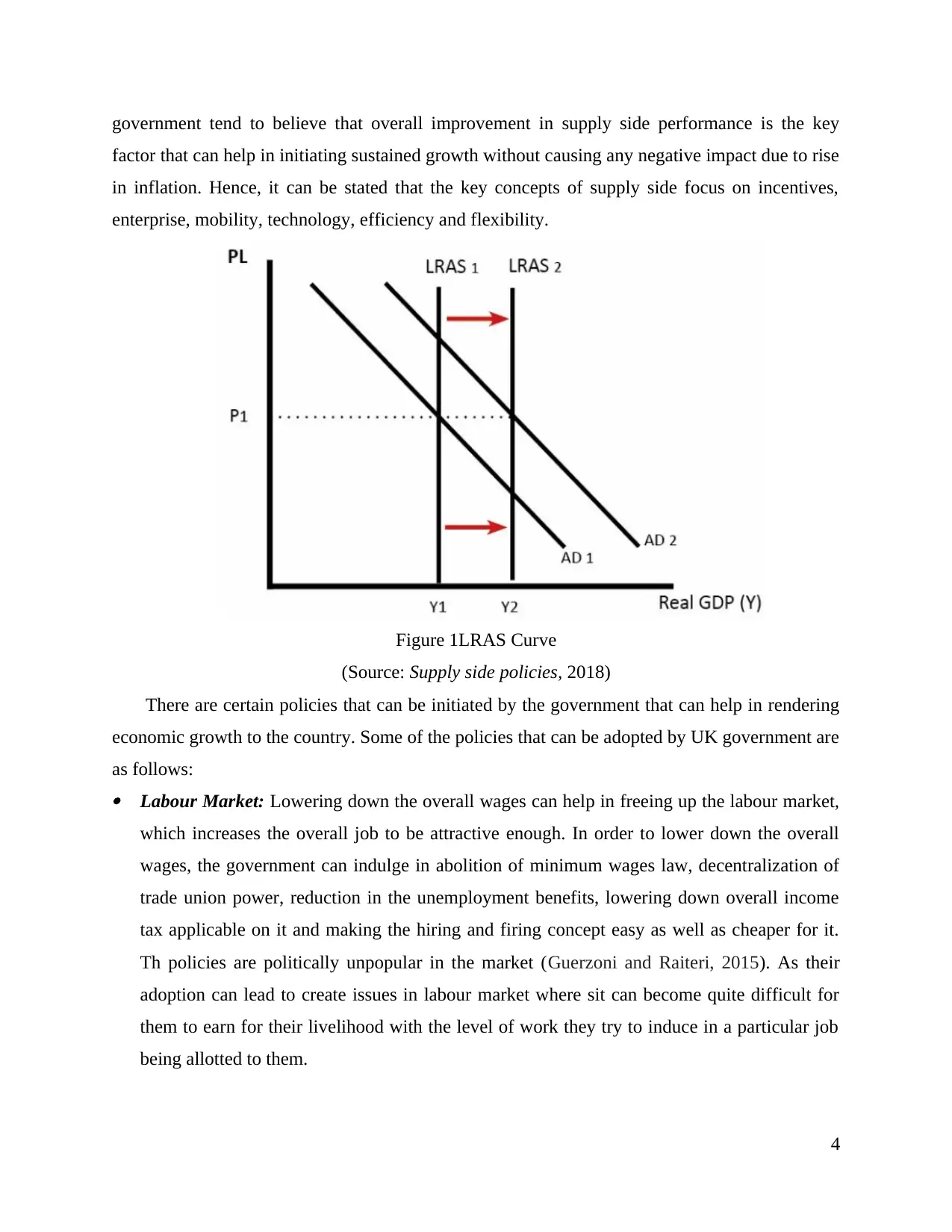
government tend to believe that overall improvement in supply side performance is the key
factor that can help in initiating sustained growth without causing any negative impact due to rise
in inflation. Hence, it can be stated that the key concepts of supply side focus on incentives,
enterprise, mobility, technology, efficiency and flexibility.
Figure 1LRAS Curve
(Source: Supply side policies, 2018)
There are certain policies that can be initiated by the government that can help in rendering
economic growth to the country. Some of the policies that can be adopted by UK government are
as follows: Labour Market: Lowering down the overall wages can help in freeing up the labour market,
which increases the overall job to be attractive enough. In order to lower down the overall
wages, the government can indulge in abolition of minimum wages law, decentralization of
trade union power, reduction in the unemployment benefits, lowering down overall income
tax applicable on it and making the hiring and firing concept easy as well as cheaper for it.
Th policies are politically unpopular in the market (Guerzoni and Raiteri, 2015). As their
adoption can lead to create issues in labour market where sit can become quite difficult for
them to earn for their livelihood with the level of work they try to induce in a particular job
being allotted to them.
4
factor that can help in initiating sustained growth without causing any negative impact due to rise
in inflation. Hence, it can be stated that the key concepts of supply side focus on incentives,
enterprise, mobility, technology, efficiency and flexibility.
Figure 1LRAS Curve
(Source: Supply side policies, 2018)
There are certain policies that can be initiated by the government that can help in rendering
economic growth to the country. Some of the policies that can be adopted by UK government are
as follows: Labour Market: Lowering down the overall wages can help in freeing up the labour market,
which increases the overall job to be attractive enough. In order to lower down the overall
wages, the government can indulge in abolition of minimum wages law, decentralization of
trade union power, reduction in the unemployment benefits, lowering down overall income
tax applicable on it and making the hiring and firing concept easy as well as cheaper for it.
Th policies are politically unpopular in the market (Guerzoni and Raiteri, 2015). As their
adoption can lead to create issues in labour market where sit can become quite difficult for
them to earn for their livelihood with the level of work they try to induce in a particular job
being allotted to them.
4
⊘ This is a preview!⊘
Do you want full access?
Subscribe today to unlock all pages.

Trusted by 1+ million students worldwide
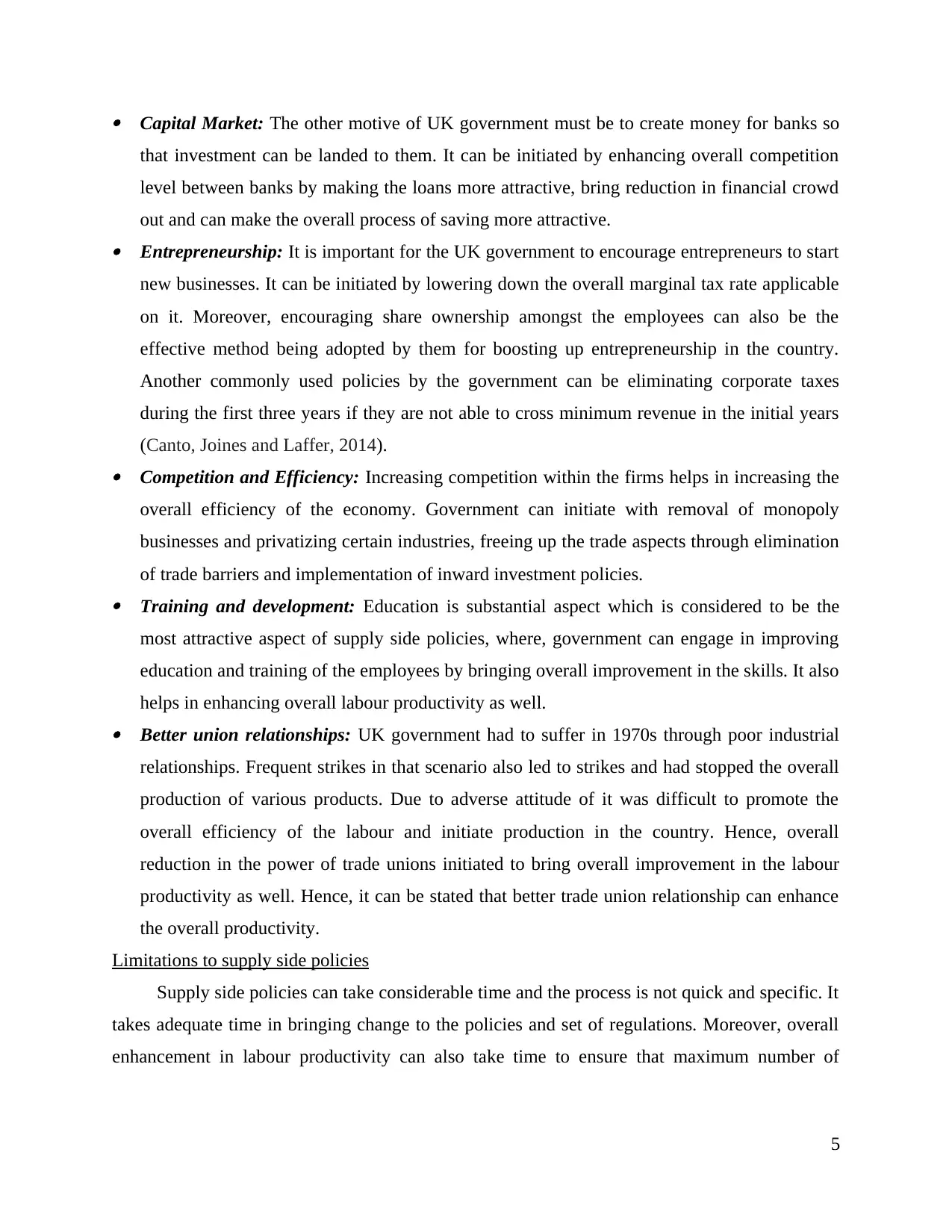
Capital Market: The other motive of UK government must be to create money for banks so
that investment can be landed to them. It can be initiated by enhancing overall competition
level between banks by making the loans more attractive, bring reduction in financial crowd
out and can make the overall process of saving more attractive. Entrepreneurship: It is important for the UK government to encourage entrepreneurs to start
new businesses. It can be initiated by lowering down the overall marginal tax rate applicable
on it. Moreover, encouraging share ownership amongst the employees can also be the
effective method being adopted by them for boosting up entrepreneurship in the country.
Another commonly used policies by the government can be eliminating corporate taxes
during the first three years if they are not able to cross minimum revenue in the initial years
(Canto, Joines and Laffer, 2014). Competition and Efficiency: Increasing competition within the firms helps in increasing the
overall efficiency of the economy. Government can initiate with removal of monopoly
businesses and privatizing certain industries, freeing up the trade aspects through elimination
of trade barriers and implementation of inward investment policies. Training and development: Education is substantial aspect which is considered to be the
most attractive aspect of supply side policies, where, government can engage in improving
education and training of the employees by bringing overall improvement in the skills. It also
helps in enhancing overall labour productivity as well. Better union relationships: UK government had to suffer in 1970s through poor industrial
relationships. Frequent strikes in that scenario also led to strikes and had stopped the overall
production of various products. Due to adverse attitude of it was difficult to promote the
overall efficiency of the labour and initiate production in the country. Hence, overall
reduction in the power of trade unions initiated to bring overall improvement in the labour
productivity as well. Hence, it can be stated that better trade union relationship can enhance
the overall productivity.
Limitations to supply side policies
Supply side policies can take considerable time and the process is not quick and specific. It
takes adequate time in bringing change to the policies and set of regulations. Moreover, overall
enhancement in labour productivity can also take time to ensure that maximum number of
5
that investment can be landed to them. It can be initiated by enhancing overall competition
level between banks by making the loans more attractive, bring reduction in financial crowd
out and can make the overall process of saving more attractive. Entrepreneurship: It is important for the UK government to encourage entrepreneurs to start
new businesses. It can be initiated by lowering down the overall marginal tax rate applicable
on it. Moreover, encouraging share ownership amongst the employees can also be the
effective method being adopted by them for boosting up entrepreneurship in the country.
Another commonly used policies by the government can be eliminating corporate taxes
during the first three years if they are not able to cross minimum revenue in the initial years
(Canto, Joines and Laffer, 2014). Competition and Efficiency: Increasing competition within the firms helps in increasing the
overall efficiency of the economy. Government can initiate with removal of monopoly
businesses and privatizing certain industries, freeing up the trade aspects through elimination
of trade barriers and implementation of inward investment policies. Training and development: Education is substantial aspect which is considered to be the
most attractive aspect of supply side policies, where, government can engage in improving
education and training of the employees by bringing overall improvement in the skills. It also
helps in enhancing overall labour productivity as well. Better union relationships: UK government had to suffer in 1970s through poor industrial
relationships. Frequent strikes in that scenario also led to strikes and had stopped the overall
production of various products. Due to adverse attitude of it was difficult to promote the
overall efficiency of the labour and initiate production in the country. Hence, overall
reduction in the power of trade unions initiated to bring overall improvement in the labour
productivity as well. Hence, it can be stated that better trade union relationship can enhance
the overall productivity.
Limitations to supply side policies
Supply side policies can take considerable time and the process is not quick and specific. It
takes adequate time in bringing change to the policies and set of regulations. Moreover, overall
enhancement in labour productivity can also take time to ensure that maximum number of
5
Paraphrase This Document
Need a fresh take? Get an instant paraphrase of this document with our AI Paraphraser
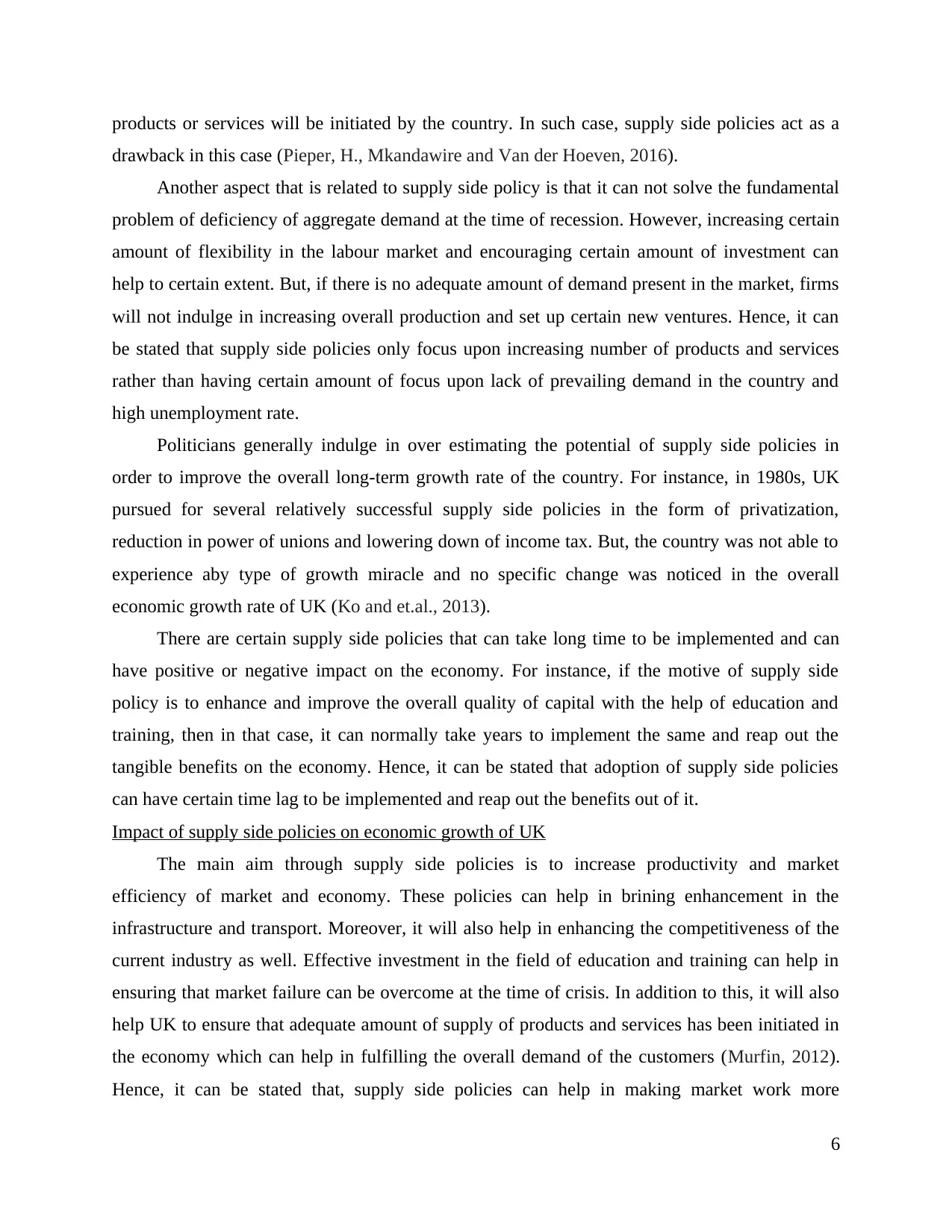
products or services will be initiated by the country. In such case, supply side policies act as a
drawback in this case (Pieper, H., Mkandawire and Van der Hoeven, 2016).
Another aspect that is related to supply side policy is that it can not solve the fundamental
problem of deficiency of aggregate demand at the time of recession. However, increasing certain
amount of flexibility in the labour market and encouraging certain amount of investment can
help to certain extent. But, if there is no adequate amount of demand present in the market, firms
will not indulge in increasing overall production and set up certain new ventures. Hence, it can
be stated that supply side policies only focus upon increasing number of products and services
rather than having certain amount of focus upon lack of prevailing demand in the country and
high unemployment rate.
Politicians generally indulge in over estimating the potential of supply side policies in
order to improve the overall long-term growth rate of the country. For instance, in 1980s, UK
pursued for several relatively successful supply side policies in the form of privatization,
reduction in power of unions and lowering down of income tax. But, the country was not able to
experience aby type of growth miracle and no specific change was noticed in the overall
economic growth rate of UK (Ko and et.al., 2013).
There are certain supply side policies that can take long time to be implemented and can
have positive or negative impact on the economy. For instance, if the motive of supply side
policy is to enhance and improve the overall quality of capital with the help of education and
training, then in that case, it can normally take years to implement the same and reap out the
tangible benefits on the economy. Hence, it can be stated that adoption of supply side policies
can have certain time lag to be implemented and reap out the benefits out of it.
Impact of supply side policies on economic growth of UK
The main aim through supply side policies is to increase productivity and market
efficiency of market and economy. These policies can help in brining enhancement in the
infrastructure and transport. Moreover, it will also help in enhancing the competitiveness of the
current industry as well. Effective investment in the field of education and training can help in
ensuring that market failure can be overcome at the time of crisis. In addition to this, it will also
help UK to ensure that adequate amount of supply of products and services has been initiated in
the economy which can help in fulfilling the overall demand of the customers (Murfin, 2012).
Hence, it can be stated that, supply side policies can help in making market work more
6
drawback in this case (Pieper, H., Mkandawire and Van der Hoeven, 2016).
Another aspect that is related to supply side policy is that it can not solve the fundamental
problem of deficiency of aggregate demand at the time of recession. However, increasing certain
amount of flexibility in the labour market and encouraging certain amount of investment can
help to certain extent. But, if there is no adequate amount of demand present in the market, firms
will not indulge in increasing overall production and set up certain new ventures. Hence, it can
be stated that supply side policies only focus upon increasing number of products and services
rather than having certain amount of focus upon lack of prevailing demand in the country and
high unemployment rate.
Politicians generally indulge in over estimating the potential of supply side policies in
order to improve the overall long-term growth rate of the country. For instance, in 1980s, UK
pursued for several relatively successful supply side policies in the form of privatization,
reduction in power of unions and lowering down of income tax. But, the country was not able to
experience aby type of growth miracle and no specific change was noticed in the overall
economic growth rate of UK (Ko and et.al., 2013).
There are certain supply side policies that can take long time to be implemented and can
have positive or negative impact on the economy. For instance, if the motive of supply side
policy is to enhance and improve the overall quality of capital with the help of education and
training, then in that case, it can normally take years to implement the same and reap out the
tangible benefits on the economy. Hence, it can be stated that adoption of supply side policies
can have certain time lag to be implemented and reap out the benefits out of it.
Impact of supply side policies on economic growth of UK
The main aim through supply side policies is to increase productivity and market
efficiency of market and economy. These policies can help in brining enhancement in the
infrastructure and transport. Moreover, it will also help in enhancing the competitiveness of the
current industry as well. Effective investment in the field of education and training can help in
ensuring that market failure can be overcome at the time of crisis. In addition to this, it will also
help UK to ensure that adequate amount of supply of products and services has been initiated in
the economy which can help in fulfilling the overall demand of the customers (Murfin, 2012).
Hence, it can be stated that, supply side policies can help in making market work more
6
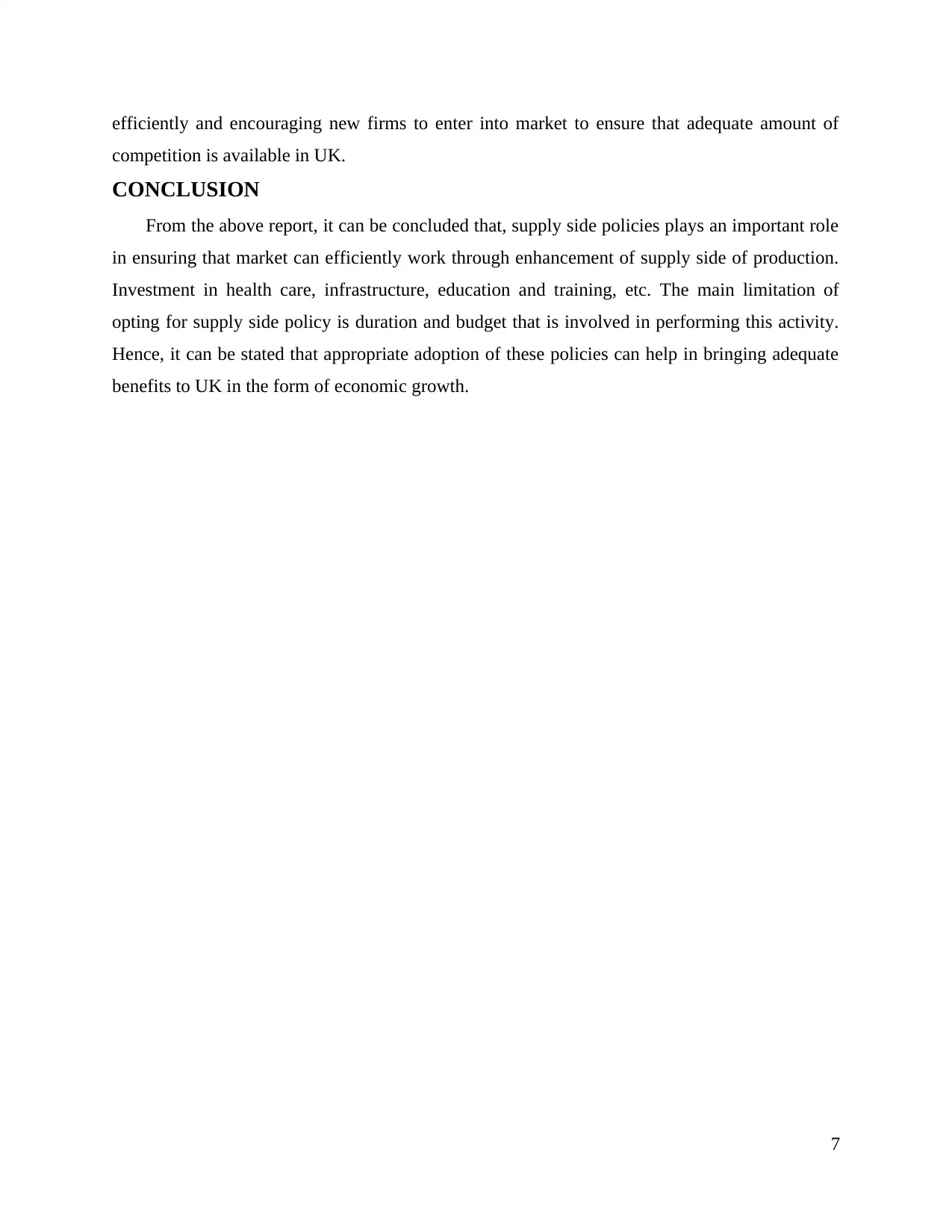
efficiently and encouraging new firms to enter into market to ensure that adequate amount of
competition is available in UK.
CONCLUSION
From the above report, it can be concluded that, supply side policies plays an important role
in ensuring that market can efficiently work through enhancement of supply side of production.
Investment in health care, infrastructure, education and training, etc. The main limitation of
opting for supply side policy is duration and budget that is involved in performing this activity.
Hence, it can be stated that appropriate adoption of these policies can help in bringing adequate
benefits to UK in the form of economic growth.
7
competition is available in UK.
CONCLUSION
From the above report, it can be concluded that, supply side policies plays an important role
in ensuring that market can efficiently work through enhancement of supply side of production.
Investment in health care, infrastructure, education and training, etc. The main limitation of
opting for supply side policy is duration and budget that is involved in performing this activity.
Hence, it can be stated that appropriate adoption of these policies can help in bringing adequate
benefits to UK in the form of economic growth.
7
⊘ This is a preview!⊘
Do you want full access?
Subscribe today to unlock all pages.

Trusted by 1+ million students worldwide
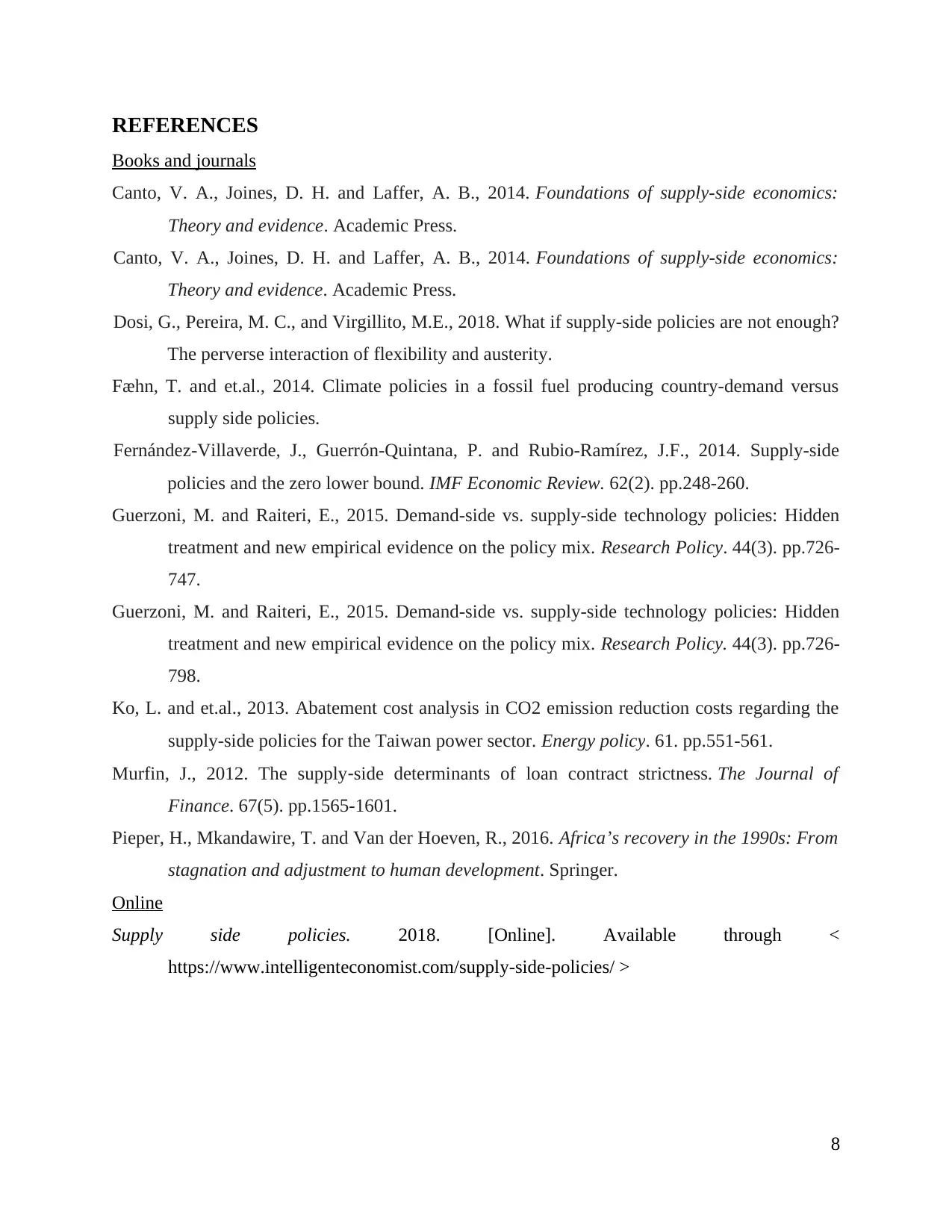
REFERENCES
Books and journals
Canto, V. A., Joines, D. H. and Laffer, A. B., 2014. Foundations of supply-side economics:
Theory and evidence. Academic Press.
Canto, V. A., Joines, D. H. and Laffer, A. B., 2014. Foundations of supply-side economics:
Theory and evidence. Academic Press.
Dosi, G., Pereira, M. C., and Virgillito, M.E., 2018. What if supply-side policies are not enough?
The perverse interaction of flexibility and austerity.
Fæhn, T. and et.al., 2014. Climate policies in a fossil fuel producing country-demand versus
supply side policies.
Fernández-Villaverde, J., Guerrón-Quintana, P. and Rubio-Ramírez, J.F., 2014. Supply-side
policies and the zero lower bound. IMF Economic Review. 62(2). pp.248-260.
Guerzoni, M. and Raiteri, E., 2015. Demand-side vs. supply-side technology policies: Hidden
treatment and new empirical evidence on the policy mix. Research Policy. 44(3). pp.726-
747.
Guerzoni, M. and Raiteri, E., 2015. Demand-side vs. supply-side technology policies: Hidden
treatment and new empirical evidence on the policy mix. Research Policy. 44(3). pp.726-
798.
Ko, L. and et.al., 2013. Abatement cost analysis in CO2 emission reduction costs regarding the
supply-side policies for the Taiwan power sector. Energy policy. 61. pp.551-561.
Murfin, J., 2012. The supply‐side determinants of loan contract strictness. The Journal of
Finance. 67(5). pp.1565-1601.
Pieper, H., Mkandawire, T. and Van der Hoeven, R., 2016. Africa’s recovery in the 1990s: From
stagnation and adjustment to human development. Springer.
Online
Supply side policies. 2018. [Online]. Available through <
https://www.intelligenteconomist.com/supply-side-policies/ >
8
Books and journals
Canto, V. A., Joines, D. H. and Laffer, A. B., 2014. Foundations of supply-side economics:
Theory and evidence. Academic Press.
Canto, V. A., Joines, D. H. and Laffer, A. B., 2014. Foundations of supply-side economics:
Theory and evidence. Academic Press.
Dosi, G., Pereira, M. C., and Virgillito, M.E., 2018. What if supply-side policies are not enough?
The perverse interaction of flexibility and austerity.
Fæhn, T. and et.al., 2014. Climate policies in a fossil fuel producing country-demand versus
supply side policies.
Fernández-Villaverde, J., Guerrón-Quintana, P. and Rubio-Ramírez, J.F., 2014. Supply-side
policies and the zero lower bound. IMF Economic Review. 62(2). pp.248-260.
Guerzoni, M. and Raiteri, E., 2015. Demand-side vs. supply-side technology policies: Hidden
treatment and new empirical evidence on the policy mix. Research Policy. 44(3). pp.726-
747.
Guerzoni, M. and Raiteri, E., 2015. Demand-side vs. supply-side technology policies: Hidden
treatment and new empirical evidence on the policy mix. Research Policy. 44(3). pp.726-
798.
Ko, L. and et.al., 2013. Abatement cost analysis in CO2 emission reduction costs regarding the
supply-side policies for the Taiwan power sector. Energy policy. 61. pp.551-561.
Murfin, J., 2012. The supply‐side determinants of loan contract strictness. The Journal of
Finance. 67(5). pp.1565-1601.
Pieper, H., Mkandawire, T. and Van der Hoeven, R., 2016. Africa’s recovery in the 1990s: From
stagnation and adjustment to human development. Springer.
Online
Supply side policies. 2018. [Online]. Available through <
https://www.intelligenteconomist.com/supply-side-policies/ >
8
1 out of 10
Related Documents
Your All-in-One AI-Powered Toolkit for Academic Success.
+13062052269
info@desklib.com
Available 24*7 on WhatsApp / Email
![[object Object]](/_next/static/media/star-bottom.7253800d.svg)
Unlock your academic potential
Copyright © 2020–2025 A2Z Services. All Rights Reserved. Developed and managed by ZUCOL.





